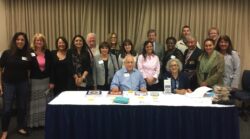It’s been two years since the shooting and subsequent riots in Ferguson. One year after that event, I wrote about having the dubious honor of witnessing three generations of protests related to race, inequality and injustice. In the 1960s, protest marches were televised nationally, inspiring many of us. Yes, some protests became violent riots, but some gave rise to long-term institutions promoting racial equality. Those of us deeply invested in the movement shared a vision and were committed to making a difference through advocacy, education, politics, and, as I did, urban planning. However, after the shootings of unarmed African American men in Baton Rouge and St. Paul, the killing of police officers in Dallas, the numerous street protests, and the ongoing threats, I am less hopeful than I was coming out of the sixties.
Continue reading Riots & Race: Then, Now and Next? – by Deborah Levine

 We are still dealing with the Atlanta area shooting of African American jogger, and now the death of George Floyd by law enforcement. In the midst of this violence, Chattanooga announced progress in creating a physical space to remember the lynching of an African American more than a century ago. The memorial will be a contemplative space near the Walnut Street Bridge and despite the pandemic, the expectation is that people will come to learn, reflect, mourn and learn from history. And hopefully, to apply those lessons going forward
We are still dealing with the Atlanta area shooting of African American jogger, and now the death of George Floyd by law enforcement. In the midst of this violence, Chattanooga announced progress in creating a physical space to remember the lynching of an African American more than a century ago. The memorial will be a contemplative space near the Walnut Street Bridge and despite the pandemic, the expectation is that people will come to learn, reflect, mourn and learn from history. And hopefully, to apply those lessons going forward
 I was excited to return to Cincinnati where my father had been the CFO of the American Jewish Archives. I was on the road, speaking on Religious Diversity in our Schools and at Work at the invitation of a Women of Faith event sponsored by American Jewish Committee, Xavier University & the Brueggeman Center for Dialogue, Islamic Center of Greater Cincinnati, and the Jewish Community Relations Council.
I was excited to return to Cincinnati where my father had been the CFO of the American Jewish Archives. I was on the road, speaking on Religious Diversity in our Schools and at Work at the invitation of a Women of Faith event sponsored by American Jewish Committee, Xavier University & the Brueggeman Center for Dialogue, Islamic Center of Greater Cincinnati, and the Jewish Community Relations Council.